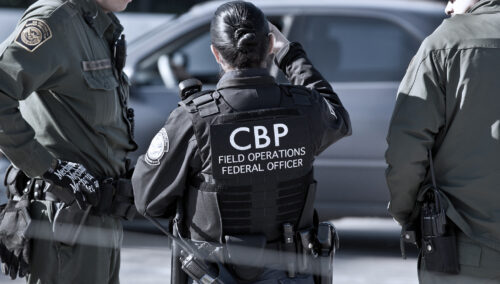With roughly 11 million unauthorized immigrants living in the United States, some question whether the nation’s immigration laws are being seriously enforced. In truth, due to legal and policy changes in recent years, the immigration laws are enforced more strictly now than ever before. The Department of Homeland Security (DHS) has reported record numbers of removals during the Obama administration, especially of noncitizens with criminal convictions. Meanwhile, fewer noncitizens are trying to enter the country illegally, and those caught by the Border Patrol are now regularly charged with federal crimes. Together, these trends reflect a sweeping and punitive transformation in U.S. immigration enforcement.
“Removals” & “Returns”
When noncitizens who violate the immigration laws are forced to leave the United States, their departure is classified as a “removal” or a “return.” (See the glossary for definitions of these terms.) DHS reported 391,953 “removals” during the 2011 fiscal year, slightly below the record set in 2009. Meanwhile, DHS reported 323,542 “returns” in 2011, the lowest number since 1970 {Figure 1}.
Figure 1: DHS “removals” & “returns” FY 2002-2011

Both figures continue a trend in which the number of “removals” has steadily risen while the number of “returns” has drastically fallen. This trend is important because it reflects a significant change in apprehension patterns. While “returns” generally occur along the border, “removals” typically involve noncitizens already residing in the United States. Thus, the rising number of “removals” and falling number of “returns” suggests that more noncitizens are now being deported from the country than are caught trying to enter illegally in the first place.
The total number of “removals” and “returns” reported by DHS should not be confused with those reported by U.S. Immigration and Customs Enforcement (ICE), an agency within DHS. In fiscal 2011, ICE reported 319,077 “removals,” a record for the agency {Figure 2}. (Note: ICE figures sometimes conflate “removals” and “returns.” In 2011, for example, ICE announced that it “removed” 396,096 noncitizens, a figure that included 77,829 “returns.” Similarly, ICE recently reported 409,849 “removals” for fiscal 2012, a figure that includes an unknown number of “returns.”)
Figure 2: ICE “removals” & “returns,” FY 2007-2011

Accounting for These Trends
With regard to DHS as a whole, there are at least three overlapping explanations why the annual number of “returns” has fallen for much of the last decade while the number of “removals” has risen. First, as previously noted, noncitizens caught crossing the border are generally “returned” rather than “removed,” and the Border Patrol has made fewer “apprehensions” (i.e. arrests) in each of the last seven fiscal years. In fiscal 2011, the number of apprehensions (340,252) made by Border Patrol agents represented a 27 percent decrease from 2010 and the lowest total in 40 years {Figure 3}.
Figure 3: Border Patrol “apprehensions” & DHS “returns,” FY 2002-2011

Second, through the expansion of the Secure Communities program, ICE is now able to cross-check the fingerprints of persons arrested by state and local police against those in its own databases. For example, in July 2009, when Secure Communities had been deployed in fewer than 80 jurisdictions, the program resulted in fewer than 12,000 fingerprint matches. In July 2012, when Secure Communities was active in more than 3,000 jurisdictions, the program resulted in nearly 44,000 fingerprint matches {Figure 4}.
Figure 4: Jurisdictions in which Secure Communities is deployed
and total fingerprint matches

Finally, changes to U.S. immigration laws enacted in 1996 permit DHS to “remove” many noncitizens without holding a hearing before an immigration judge. Under certain circumstances, for example, noncitizens may receive “expedited removal orders” and “reinstatements of removal” without having to appear in court. Indeed, the rise in “removals” over the past decade is largely due to an increase in removal orders issued by DHS officers rather than immigration judges {Figure 5}.
Figure 5: Removal orders issued by DHS officers & immigration judges, FY 2002-2011

“Criminal” & “non-criminal” removals
In recent years, DHS has attempted to prioritize the removal of “criminals” over “non-criminals.” According to DHS, noncitizens are considered “criminal” if they have ever been convicted of a crime, no matter how minor. During the 2011 fiscal year, 188,832 removals (48.1 percent) involved noncitizens who had a criminal conviction—the highest number in the last decade. Meanwhile, 203,571 removals (51.9 percent) involved noncitizens with no criminal conviction—the lowest number in five years {Figure 6}.
Figure 6: Removals involving “criminals” & “non-criminals,” FY 2002-2011

Since fiscal 2009, the most frequent types of criminal convictions for noncitizens removed from the United States involved drug, traffic, and immigration offenses. In 2011, the government removed 43,262 noncitizens convicted of drug offenses, 43,022 noncitizens convicted of traffic offenses, and 37,458 noncitizens convicted of immigration offenses {Figure 7}. As noted below, however, many of those charged with immigration offenses might just as easily have been prosecuted civilly, rendering increases in “criminal” prosecutions in this category somewhat misleading.
Figure 7: Most frequent basis for “criminal” removals, FY 2009-2011

“Illegal entry” and “illegal re-entry”
Most noncitizens charged with violating the immigration laws are removed or returned but not criminally prosecuted. In recent years, however, a growing number of noncitizens have been charged in federal criminal courts for illegally entering the country.
The rise in criminal immigration prosecutions is largely traceable to “Operation Streamline,” an effort launched during the Bush administration to bring criminal charges against noncitizens apprehended by the Border Patrol. Noncitizens prosecuted under Operation Streamline are typically charged with “illegal entry” and/or “illegal re-entry.” Illegal entry, which occurs any time a noncitizen enters the country in violation of the law, is a federal misdemeanor punishable by up to 180 days in prison. Illegal re-entry, which occurs when a noncitizen unlawfully returns after a prior order of removal, is a federal felony punishable by up to two years in prison.
In fiscal 2010, the most recent year for which figures are available, the Justice Department brought charges of illegal entry in 43,300 cases and illegal re-entry in 35,390 cases. The number of charges for illegal entry represented a slight decline from prior fiscal years, while the number of illegal re-entry charges marked the highest figure in U.S. history {Figure 8}.
Figure 8: Criminal charges for “illegal entry” and “illegal re-entry,” FY 2002-2011

Conclusion
Over the past decade, immigration enforcement has undergone a fundamental transformation in the United States. Due to changes to the immigration laws and the expansion of the Secure Communities program, more noncitizens are being “removed” than ever before—making it more difficult for them to return legally to the United States and exposing them to felony charges if they re-enter the country illegally. Meanwhile, the number of apprehensions along the border has fallen to levels not seen since the early 1970s, and the government now regularly prosecutes noncitizens for illegally entering and re-entering the country. In combination, these trends demonstrate that the immigration laws are being more strictly enforced today than ever before.
Glossary
Apprehension: An arrest made by an officer of the Department of Homeland Security.
Expedited removal: The summary removal of a noncitizen who does not possess valid entry documents or is inadmissible for fraud or misrepresentation of material fact. Such removals may take place without a hearing before an immigration judge.
Illegal entry: the unlawful entry of a noncitizen into the United States.
Illegal re-entry: the unlawful entry of a noncitizen after a prior order of removal.
Reinstatement of removal: A removal based on the reinstatement of a prior removal order, where the noncitizen departed the United States under an order of removal and illegally attempted to enter or is at any time found in the United States. Such removals may take place without a hearing before an immigration judge.
Removal: The compulsory and confirmed departure of a noncitizen based on an order of removal (formerly known as an order of “deportation”). Noncitizens who are removed may suffer administrative or criminal consequences if they illegally re-enter the country.
Return: The confirmed departure of a removable noncitizen not based on an order of removal (e.g. a grant of voluntary departure).



